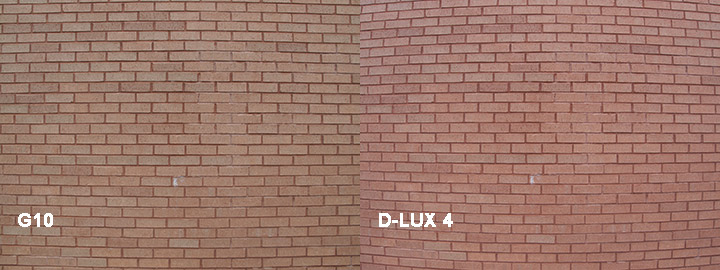Number 1 on the list is a tie between the Leica D-LUX 4 and the Panasonic DMC-LX3.
Panasonic created a stir when they announced the LX3. Much of the media attention centered around Panasonic's "brave" decision not to increase the megapixel count despite the fact that they were nominally increasing sensor size. In fact, the LX3 has the same 2.0 micron sensor pixel pitch as the LX2, with advances in sensor technology contributing to relatively modest improvements in noise performance and dynamic range.
The LX3 truly broke new ground by incorporating a brand new f//2-2.8 wide zoom lens starting at 24mm equivalent. Only Ricoh had previously brought forth a lens this wide in a compact, and not since 2006 had we seen a zoom this fast in a fixed lens camera. Yet unlike the fast zooms on digital cameras of the past, the LX3 zoom manages a remarkably compact size. How did Panasonic manage to make such a fast zoom lens so compact? First, they limited the zoom range to the 24-60mm equivalent. Second, they made more efficient use of the imaging circle. A third factor which likely contributed to their ability to keep the lens small is that they chose to address lens flaws, namely color fringing and distortion, using in-camera processing and RAW conversion software.
The result is the camera with the fastest lens in its class coupled to a sensor with noise performance in line with its Canon peer and dynamic range which is slightly ahead, second only to the Sigma DP1. Add to that the ability to go very wide, change aspect ratios while maintaining angle of view coverage, and greater pocketability than the G10, and you have a camera which appeals to a great many photographers looking for an advanced compact camera.
There are a couple minor downsides to the LX3 and its Leica sibling. First, build quality isn't quite up to the level of the Ricoh compacts and the G10. Switches, buttons, and covers don't have that same robust feel. Second, the lens cover is clumsy compared to an integrated cover like the one on the G10 and GRD. Yet the LX3 lens cover provides greater protection than does the integrated approach.
One significant drawback to the LX3 lens design is that there is severe barrel distortion on the wide end. Here you can see the G10 barrel distortion compared to the LX3 barrel distortion at 28mm equivalent (Note: It's worse at 24mm equivalent):
The issue isn't necessarily the barrel distortion itself. The in-camera processor does a nice job of removing this, and the RAW software distributed with both the Panasonic and Leica cameras will automatically correct it. The problem is that when you correct that much barrel distortion in software, you are throwing away quite a bit of resolution. In my own unpublished tests I've found that an LX3 RAW converted in Iridient Software's Raw Developer, which doesn't address the barrel distortion, will approach the overall detail of a Canon G10 file in the center and exceed it at the edges and corners (with both cameras at 28mm equivalent, 4:3 aspect ratio, and comparing equal size large prints). In contrast, an LX3 file which has had barrel distortion fixed is a clear step below the G10 in overall detail rendered.
However, resolution isn't everything, and the LX3 is finding its place in the pockets of many talented photographers. It is selling out of stock more than any camera in class. The controls and ergonomics of the Ricohs put them at the top of the list for many "street" photographers, but I consider the LX3 to be the compact of choice for most people photography. With a moderate but significant lens speed advantage on the Canon, Ricoh, and Nikon competitors (roughly 2/3 stop at any given angle of view versus the Canon), it is certainly the best with moving subjects when light challenged.
A few words specifically about the Leica D-LUX 4: The mention of this camera always seems to incur general annoyance if not venom. Some among the Leica crowd get genuinely upset at the suggestion that this is a Leica camera, and there is always someone around to state that "buying the D-LUX is stupid because the LX3 is the same camera for much less money." I listed both cameras as a tie here, because I think the D-LUX 4 is every bit as legitimate as the LX3. Leica likes it enough to refer to it as the "Son of M8", so regardless of who designed the lens (Panasonic) or who makes it (Panasonic), it is a Leica. Let's look at it another way. The typical price of a D-LUX 4 these days, given current promotions, is about $650. Meanwhile, the LX3 sells for about $430 new. That's $220 extra for the Leica. In a few years, the D-LUX will probably resell for ~$300, the LX for ~$200 (based on my experience selling Leica and Panasonic compacts). At that point, one will have paid net $120 extra for the Leica. What one gets for that $120: 1) Fashion and branding which make some people want to use the camera more; 2) Longer warranty (2 years vs 1); 3) Capture One software ($100 value if purchased separately). Whether that is worth it to the individual is a personal decision, but it certainly isn't "stupid" to go one way or the other.
----------------------------------------------
Disclosure: I have purchased and owned all the cameras on this list other than numbers 4 (GX200), 6 (Rebel XS), and 7 (GRD II). I currently own only numbers 5 (Olympus XA) and 8 (Fuji F200EXR). I have used all cameras on the list enough to get to know them with the exception of the GX200, as I indicated when I listed it.




